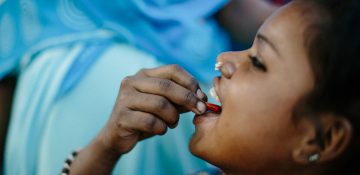Contact tracing with prophylactic treatment could near-eliminate leprosy
Post-exposure prophylaxis with a single dose of the antibiotic rifampicin is safe, can be integrated into different leprosy control programs, and is generally well accepted by patients, their contacts, and health-care workers

New results from the largest ever research programme on combining contact tracing with prophylactic treatment, the Leprosy Post-Exposure Prophylaxis (LPEP) programme, published the results in the peer-reviewed journal The Lancet Global Health. The Novartis Foundation-initiated programme covered more than 150,000 people across seven countries. NLR contributed intensively during the study.
Use of post-exposure prophylaxis is expected to interrupt transmission of the bacteria causing leprosy, meaning that if this approach is scaled up globally near-elimination of the disease could become a reality in a single generation.
The results of the five-year LPEP programme, published yesterday in The Lancet Global Health, evaluated the feasibility and efficiency of systematic contact tracing, screening and administration of prophylactic treatment to eligible contacts of individuals newly diagnosed, such as household members, neighbours, or co-workers.
The international multicentre study with the leprosy control programmes of Brazil, India, Indonesia, Myanmar, Nepal, Sri Lanka, and Tanzania, is by far the most comprehensive attempt to evaluate this approach to a disease, which still sees over 200,000 people newly diagnosed every year.
Ann Aerts, Head of the Novartis Foundation, commented: “These results mean we can finally imagine a world without leprosy. By using contact-tracing and prophylactic treatment in combination with widespread availability of multi-drug therapy and other tools, we can cover the last mile in the elimination of this disease. We would like to thank the governments, NGOs and investigators who worked with us to make this landmark initiative a reality, enabling post-exposure prophylaxis to be translated into global health policy.”
Use of post-exposure prophylaxis with a single dose rifampicin (SDR-PEP) has already been shown to reduce the risk of leprosy in contacts of leprosy patients by nearly 60%. As a result, the World Health Organization (WHO) recommended the intervention in their 2018 Guidelines for the Diagnosis, Treatment and Prevention of Leprosy.
The LPEP programme demonstrated that once contact tracing has been established, including prophylactic treatment can be achieved with minimal additional effort.
Jan van Berkel, CEO of NLR and President of the International Federation of Anti-Leprosy Associations (ILEP) commented on how post-exposure prophylaxis could help patients manage the impact of the disease. “With this new approach, there is a much lower chance people with leprosy can pass on disease to neighbors and friends, preventing avoidable disability and stigma, in turn helping us to progress towards zero leprosy. We need to see this prophylactic approach applied everywhere.”
About the LPEP study partners
The LPEP partners who conducted this study with the Novartis Foundation include the National Leprosy Programs of Brazil, India, Indonesia, Myanmar, Nepal, Sri Lanka and Tanzania. They were supported by several International Federation of Anti-Leprosy Associations (ILEP) members: American Leprosy Missions, FAIRMED, the German Leprosy and TB Relief Association, and NLR – until No Leprosy Remains; and academic institutions: Erasmus MC, University Medical Center Rotterdam, Instituto Lauro de Souza Lima, the Swiss Tropical and Public Health Institute, and Universidade do Estado de Mato Grosso.
